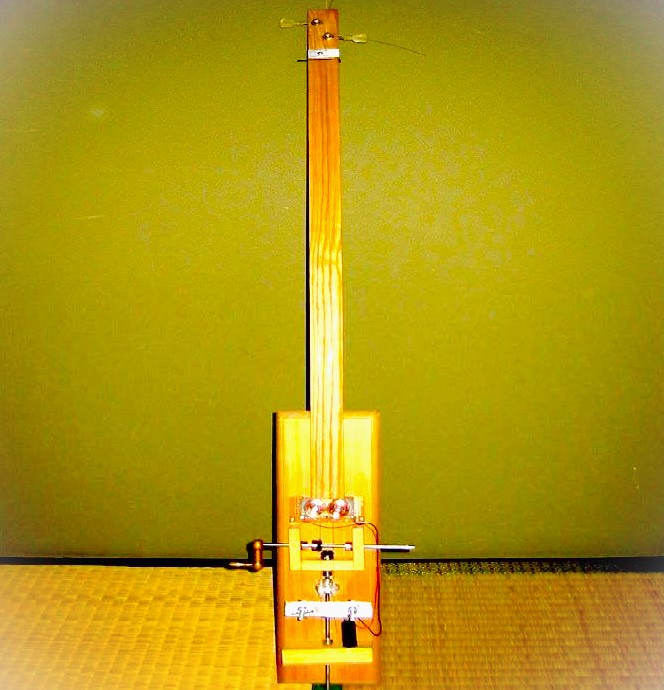Kaisatsuko
Bowed Instruments
Asia
Between 1901 and present
Video
The Kaisatsuko is a fascinating musical instrument that stands out due to its unique design and mechanism. Developed in Japan, this two-stringed instrument combines traditional craftsmanship with modern innovation, resulting in a sound that is both captivating and distinctive.
Description and Working Mechanism
The Kaisatsuko is often described as a wheel-bowed fiddle, which means it utilizes a rotating wheel to produce sound instead of the traditional bow used in string instruments. This innovative design was conceived by Yuichi Onoue in 2003. The instrument features two strings that are vibrated by a small hand crank that spins a nylon wheel. As the wheel rotates against the strings, it creates a sustained drone sound that is characteristic of the Kaisatsuko. The body of the Kaisatsuko is typically made from wood, giving it a warm resonance. The strings can be made from various materials, including nylon or gut, depending on the desired tonal quality. The instrument is played by turning the hand crank, allowing musicians to control the speed and intensity of the sound produced. This method of sound production is reminiscent of other historical instruments like the hurdy-gurdy, which also employs a wheel mechanism to vibrate strings.
One of the most intriguing aspects of the Kaisatsuko is its ability to produce a wide range of sounds. Musicians can create everything from soft drones to more pronounced melodies by adjusting their playing technique and the tension on the strings. This versatility makes it suitable for various musical styles and genres.
History of Kaisatsuko
The Kaisatsuko’s origin can be traced back to Japan in the early 21st century. While it is a relatively modern invention, its design draws inspiration from ancient string instruments that utilized similar mechanisms for sound production. The concept of using a wheel to bow strings has historical roots in Europe, particularly with instruments like the hurdy-gurdy, which dates back to at least the 11th century. Japan has a rich history of string instruments, including traditional ones like the shamisen and koto. However, the Kaisatsuko represents a departure from these classical forms by incorporating contemporary materials and design principles. Its creation reflects a broader trend in modern music where musicians seek to innovate and experiment with new sounds while paying homage to traditional practices. As an experimental instrument, the Kaisatsuko exemplifies how musicians can blend old techniques with new technologies to create something entirely unique. It serves as a testament to Japan’s ongoing evolution in musical expression and creativity.
Types and Features
While there may not be numerous distinct types of Kaisatsuko due to its relatively recent development, variations can exist based on construction materials and tuning methods. Some key features include:
Two Strings: The instrument typically has two strings that are tuned to specific pitches.
Hand Crank Mechanism: The primary feature that distinguishes it from other string instruments is its hand-cranked wheel mechanism.
Wooden Body: Most models are constructed from wood, contributing to their acoustic properties.
Electric Variation: Some modern iterations may incorporate electronic amplification for enhanced sound projection.
These features enable musicians to explore various musical styles while maintaining the instrument’s unique identity.
Kind of Music Composed
The music composed for the Kaisatsuko spans various genres and styles. Its unique sound allows for experimentation with different musical forms. Some common types of music associated with this instrument include:
- Traditional Japanese Music: The Kaisatsuko can be integrated into traditional Japanese music settings, providing a modern twist on classic melodies.
- Experimental Music: Many contemporary composers use the Kaisatsuko to explore avant-garde sounds and textures.
- Folk Music: Its drone-like qualities make it suitable for folk music compositions that emphasize storytelling through melody.
- Ambient Music: The sustained tones produced by the instrument lend themselves well to ambient music genres where atmosphere is key.
Musicians often appreciate the Kaisatsuko for its ability to evoke emotions through its soundscapes, making it an excellent choice for both solo performances and collaborative projects.
Significance in Japanese Culture
The Kaisatsuko holds significant cultural value within Japan as it represents innovation in musical tradition. By blending modern techniques with historical elements, it fosters a dialogue between past and present musical practices. This instrument serves as an example of how cultural heritage can evolve while still honoring traditional roots. Moreover, the Kaisatsuko has gained recognition among experimental musicians both in Japan and internationally. It has become a symbol of creative exploration within contemporary music scenes. As musicians continue to push boundaries with instruments like the Kaisatsuko, they contribute to an ever-expanding narrative of musical evolution.
In addition to its artistic significance, the Kaisatsuko also plays a role in educational contexts. Workshops and performances featuring this instrument help introduce new generations to innovative musical practices while encouraging them to engage with their cultural heritage. It is more than just an instrument; it embodies a fusion of tradition and innovation within Japanese music culture. Its unique design and sound production methods allow musicians to explore new sonic territories while connecting with historical practices.
FAQ
How does the Kaisatsuko work as a musical instrument?
The Kaisatsuko operates using a unique mechanism that combines elements of a traditional string instrument and a wheel bow. A rotating wheel bow is used to continuously vibrate the strings, producing sustained sounds. By pressing the keys, players can control the pitch of the notes, creating dynamic melodies.
What type of music can be played on the Kaisatsuko?
The Kaisatsuko is versatile, capable of playing a wide range of musical styles. Its continuous sound production makes it well-suited for experimental, ambient, and contemporary music, as well as traditional and classical compositions with sustained notes.
Why is the Kaisatsuko significant in modern music?
The Kaisatsuko holds significance for its ability to produce unique, sustained tones and its innovative design. It bridges the gap between traditional string instruments and modern sound experimentation, offering musicians new possibilities for expression and creativity.
 Links
Links
References
Other Instrument
Categories


















